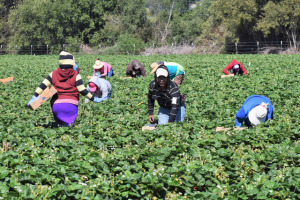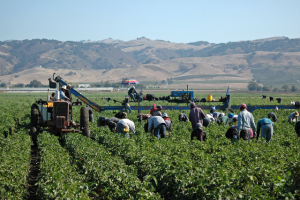California Ag Vision Continues to Impress: bold thinking shines through
September 15, 2009 Michael R. DimockI wanted to share my impressions from the second California Ag Vision process meeting held on Tuesday, September 15th. The first was held in early August. This is the stakeholder consensus building process involving approximately 100 leaders initiated by Secretary of Food and Agriculture, AG Kawamura, and the State Board of Food and Agriculture. The goal is to provide policy recommendations for the Governor that will ensure the food and agriculture system in the state is sustainable by 2030.
Overall, the second meeting was excellent, even better than the first. This is because the spirit, openness and serious search for common ground was evident. It felt more relaxed, was more enjoyable, and productive. As one ROC Council member (sorry, we are pledged to not attribute comments) said to me, “Did you hear how much laughter and joking there was? That is a good sign.” I concur.
Seriously, interesting ideas are beginning to emerge and some of them are quite bold, perhaps even too bold for the State Board of Food and Agriculture, but that remains to be seen. I remain firmly committed and even more hopeful than after the first session that we will get somewhere. The Aggies in the process are really showing up with open minds and good spirits. I was thoroughly impressed. I am actually wondering if the Enviros are thinking with as much flexibility and seriousness.
Members of ROC’s network were again well represented. Here is a list: Eric Cardénas, Jim Cochran, Martha Guzman, Luawanna Hallstrom, Cesar Hernandez, Edie Jessup, Jonathan Kaplan, Holly King, Mark Kramer, Adán Ortega, Jovita Pajarillo, and Richard Rominger were all in the rooms. I say “rooms” because we spent nearly the entire day broken into three groups: Healthy Planet, Thriving Communities, and Better Health. Thus, I am providing mainly a perspective on my group, Thriving Communities, because that is where I spent time. Secretary Mike Chrisman of the Resources Agency was with us in the Thriving Communities group for most of the day. He was a great addition.
We did one basic thing the entire meeting. We developed a large set of bold steps, which we began to put into recommendation form. We (the three groups combined) had probably 20 or more draft recommendations by the end of the day.
Here is how we did it. Each room broke into even smaller groups of roughly five to seven people within to work through specific ideas that emerged in the first meeting, in two rounds (one in the morning and one in the afternoon). Thriving Communities focused on water, labor, and markets. I participated in one of the two water discussions in the morning and the labor discussion in the afternoon. To guide our work, we were given a template to fill in that provided a framework for describing the recommended bold idea to the State Board.
Here is what we did in the first water meeting. The “draft” bold idea is that the State Board will take the lead in creating a coalition of Enviros, Urbanites, Regulators, and Aggies who are in agreement on 80% of the water issues currently being debated. This idea rests on a belief among those at the table (some of whom are at the very center of the State’s struggle) that there is in fact agreement on 80% of the issues, that 10% of the issues are unresolved because we still need more science, knowledge, or dialog, and that the last 10% is irresolvable due to dogma or “religion,” (as one veteran of the water wars stated) strongly held by one or the other group. The “boldness” is that agriculture — led by the State Board –will embrace the water needs of Enviros and Urbanites and fight for them because it realizes it cannot move forward without such an alliance.
Our team recommended that the Board begin by empowering a small, but diverse, group of stakeholders with capacity to dialog that will write down the 80% agreement and clarify what will occur if we don’t move forward on this position, even if it means some land goes fallow and some species are impacted. Once we have clarity on the path provided by the 80% agreement, a compelling or “game changing message” would be developed, perhaps an Inconvenient Truth type film could be produced. Then a CA Water Congress would be organized to which representatives would be called from the aforementioned sectors. The task of the Congress would be to forge an agreement on sustainable water policy for the state. Then all members of the coalition would in unity call for legislative action. To me, this is a bold idea.
On labor, the bold idea is to pass a CA Immigration Reform Actto decriminalize agricultural labor (workers and employers). It would touch on specific issues the state has jurisdiction over. For instance, the law enforcement might no longer stop Latinos in cars just to see if they have CA Drivers licenses, as they do in some places as way to identify and arrest “illegal’s.” Or state and local police might stop cooperating with federal immigration police when they make raids on farm labor camps or packing facilities. The goals would be to help farm operators and workers to cope with the bad federal policy and to provide the Fed and other states with a beacon for righting the current wrong. The legislation might also be used to boost enforcement of current safety regulations and offer incentives for farm labor housing and health insurance. A CA Immigration Reform Act is another very bold idea. As one ROC Council member said, the conversation among those discussing labor was surprisingly productive.
So those are just two examples of what is emerging. Some ideas are clearly less bold than others, but enough boldness is now emerging to cause me some real enthusiasm for the Ag Vision effort. Stakeholders will not meet face-to-face again until December. Between now and then, teleconferences and on-line writing will hone the many ideas currently under development. The State Board will have a chance to review the many recommendations and then there will be a public comment period. We will certainly alert the ROC Network and ask it to weigh in when the time comes. Secretary Kawamura ended the session with sincere thanks for the leadership being shown and for the funders who have made the unprecedented work possible, including Heller and Columbia foundations, two of ROC’s core funders.



